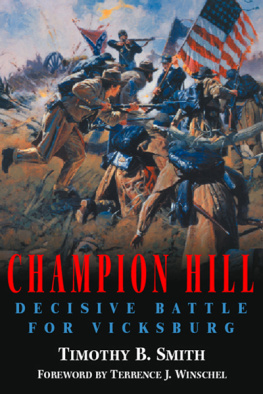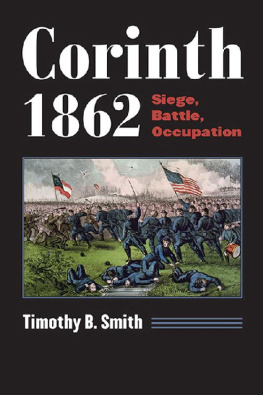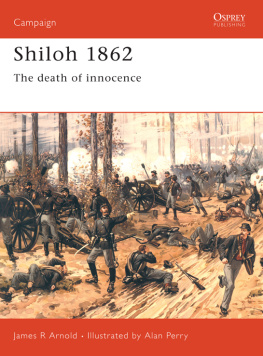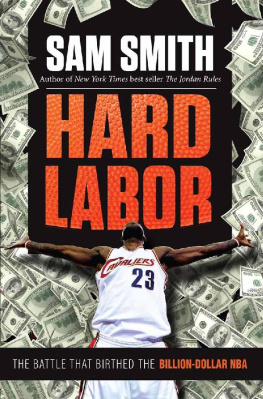Contents
Shiloh
MODERN WAR STUDIES
Theodore A. Wilson
General Editor
Raymond Callahan
Jacob W. Kipp
Allan R. Millett
Carol Reardon
Dennis Showalter
David R. Stone
James H. Willbanks
Series Editors
SHILOH

Conquer or Perish

TIMOTHY B. SMITH

2014 by the University Press of Kansas
All rights reserved
Published by the University Press of Kansas (Lawrence, Kansas 66045), which was organized by the Kansas Board of Regents and is operated and funded by Emporia State University,
Fort Hays State University, Kansas State University, Pittsburg State University, the University of Kansas, and Wichita State University
Library of Congress Cataloging-in-Publication Data
Smith, Timothy B., 1974
Shiloh : conquer or perish / Timothy B. Smith.
pages cm. (Modern war studies)
Includes bibliographical references and index.
ISBN 978-0-7006-1995-5 (cloth) ISBN 978-0-7006-2347-1 (paperback)
ISBN 978-0-7006-2039-5 (ebook)
1. Shiloh, Battle of, Tenn., 1862.I. Title.
E473.54.S6352014
973.731dc23
2014019701
British Library Cataloguing-in-Publication Data is available.
Printed in the United States of America
10987654321
The paper used in this publication is recycled and contains 30 percent postconsumer waste. It is acid free and meets the minimum requirements of the American National Standard for Permanence of Paper for Printed Library Materials Z39.48-1992.
To
Kelly, Mary Kate, and Leah Grace
and
Mom and Dad
CONTENTS
LIST OF MAPS
PREFACE
Shiloh holds a special place in my heart. My parents began taking me there when I was seven, and since then I have had the privilege of visiting, working at, and living on the Shiloh National Military Park. Many memories stand out, not the least of which are working for the National Park Service and living for several years in park housing right on the battlefield. Leading tours with the likes of Charles P. Roland and John F. Marszalek were special treats as well. Another fond memory is standing with Shiloh historians Wiley Sword and James Lee McDonough, along with others such as present Fort Donelson National Battlefield superintendent Brian McCutchen, at Albert Sidney Johnstons death site(s) on the afternoon of April 6, 2012, exactly 150 years to the time of his death. Ironically, while I had numerous ancestors inside Vicksburg (and that battlefield definitely holds a special meaning to me), I had no one at Shiloh. But it is still my most beloved battlefield.
Perhaps that is the reason I have spent a good deal of my historical career studying the battle and battlefield. Over the years I have written nearly a score of articles and chapters in books, published two volumes of essays, coedited the famous Cunningham manuscript, and written or edited four other books on Shilohs battle and battlefield. Yet I could never bring myself to write a full battle historyuntil now. Fortunately, those detailed essays and articles have been extremely helpful in fashioning this more general narrative, and readers who desire more specifics on my thinking in the present book should consult those earlier texts.
Why another book on Shiloh? Foremost, the literature on the battle, while respectable, is not nearly as exhaustive as that of Gettysburg or even other battles. There have been, to be sure, a number of volumes that treat the battle in various ways, from novels to guides and many in between, but there have only been four major academic studies to date, by historians Edward Cunningham, Wiley Sword, James L. McDonough, and Larry Daniel. The freshest research is that of Daniel (Cunninghams was written in the 1960s though only published in 2007), and it is now nearly twenty years old.
There is plenty new to say. Even with the major books already in print, I hope to add several major attributes in this present study. One is a new way of organizing the battle. Civil War buffs and even some historians regularly comment about how fluid and confusing Shiloh was. Veteran Manning Force rightly commented, A combat made up of numberless separate encounters of detached portions of broken lines, continually shifting position and changing direction in the forest and across ravines, filling an entire day, is almost incapable of a connected narrative. Another veteran, Lewis M. Hosea, added a particularly adept view of the confusion of Shiloh:
It was impossible for commanders of large bodies to obtain a comprehensive view of the field so as to perceive and provide intelligently for the varying exigencies of the battle as it progressed. They could only guess the swaying movements of the fight by sounds of musketry and the chance reports of messengers, who could locate nothing by fixed monuments. Nor could the men in ranks, or even regimental officers, see beyond a limited distance; and the direction of enfilading or turning movements could be discovered only by the course of bullets among the trees or the tearing of the ground by solid shot or shell.
Obviously, we have a little better overall understanding today than the men on the ground had in the midst of the fighting, but Shiloh is still confusing. By tying the action to the terrain and using physical features to organize the battle into phases and sectors within those phases, however, I hope readers will come away from this book with a clearer understanding of how the action unfolded in time and space. I also hope readers will gain an understanding of just how important terrain was at Shiloh; it was, in my mind, one of the two chief determining factors (the other being Ulysses S. Grant) of victory and defeat. William T. Sherman later summed up the terrains significance: On any other [ground] we surely would have been overwhelmed.
Another major goal of this book is to spend nearly as much time on the second days fighting as on the first. We already know there was heavy action on the second day, with one Illinoisan writing that the fighting commenced at day break & lasted with one continual stunning roar until 4 P.M. Yet most historians have given the second day less attention; indeed, each of the main studies on Shiloh gives the second day less than 10 percent of its text. Attendant to this lack of examination is the idea that the second day was a done deal and really did not matter. In examining this second day in detail within the context of the overall battle, I argue that it was not a done deal and that it was much more important to the central battle than is often thought.
Last, Shiloh was not fought in a vacuum, and there were numerous social ramifications of the battle. Whereas other historians, particularly Larry Daniel, have sought to place the battle in its correct political and economic context, I chose to use my limited space not in rehashing what has already been argued and published but in examining other social aspects of Shiloh. Thus, I have put much emphasis on the soldiers themselves, letting them tell the story through their own words, and on the local population and how the battle affected them. I hope readers will come away with a heightened sense of just how important Shiloh was to the civilians in the area and to the Civil Wars strategic situation.









